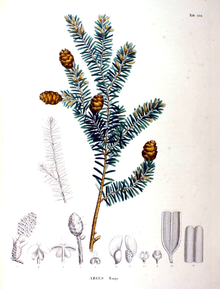Tsuga sieboldii
| Southern Japanese hemlock | |
|---|---|

| |
| Drawing from 1870 Flora Japonica, Sectio Prima | |
| Scientific classification | |
| Kingdom: | Plantae |
| Clade: | Tracheophytes |
| Clade: | Gymnospermae |
| Division: | Pinophyta |
| Class: | Pinopsida |
| Order: | Pinales |
| Family: | Pinaceae |
| Genus: | Tsuga |
| Species: | T. sieboldii
|
| Binomial name | |
| Tsuga sieboldii | |
| Synonyms | |
| |
Tsuga sieboldii, also called the southern Japanese hemlock, or in
the tree is sometimes used as an ornamental and has been in cultivation since 1861.Description
The tree is often multiple-stemmed from the base and the dense crown is broadly conical and pointed. The
buds are narrow based and ovoid, dark orange in colour. Their scales are convex.[1]
The staminate (i.e. male) flowers are terminal on weak shoots. They are very small at only 2 mm (0.079 in), globular in shape and cherry-red in colour. The pistillate flowers are slightly larger at 5 mm (0.20 in), purple in colour and nodding ovoid in shape. The deep dark brown cones are pendulous and ovoid-conic in shape. The tips are blunt and they measure about 2.3 cm long by 1.3 cm (0.51 in) wide. Their scales are flat topped.[1]
References
- ^ ISBN 0-00-219213-6.
